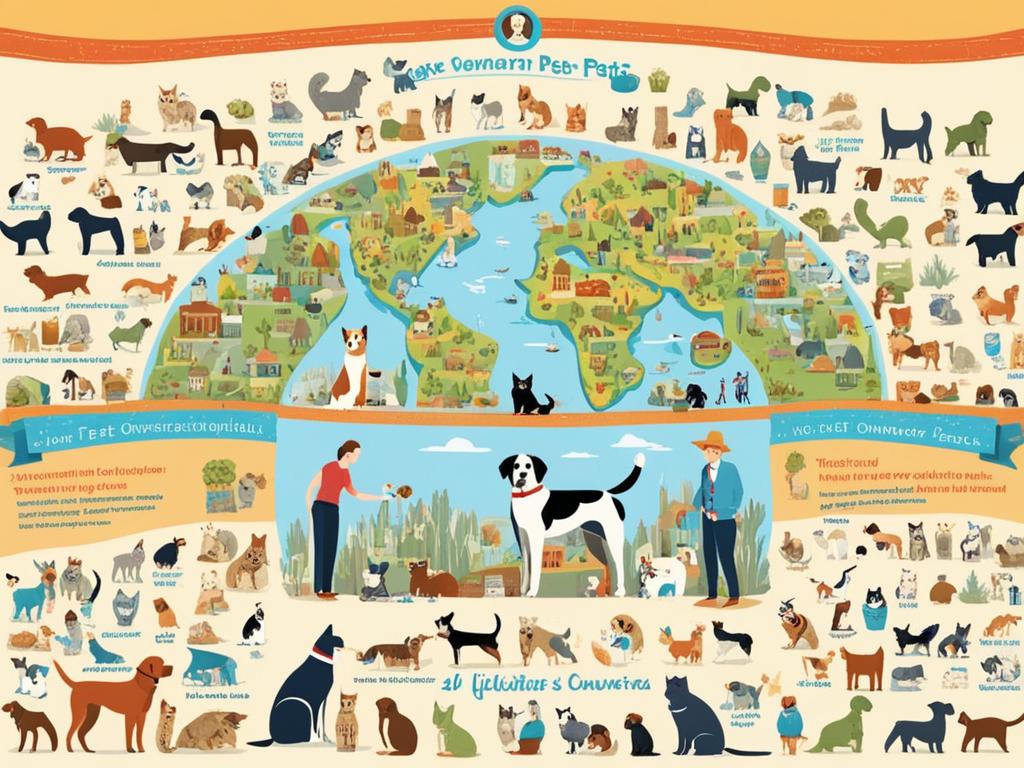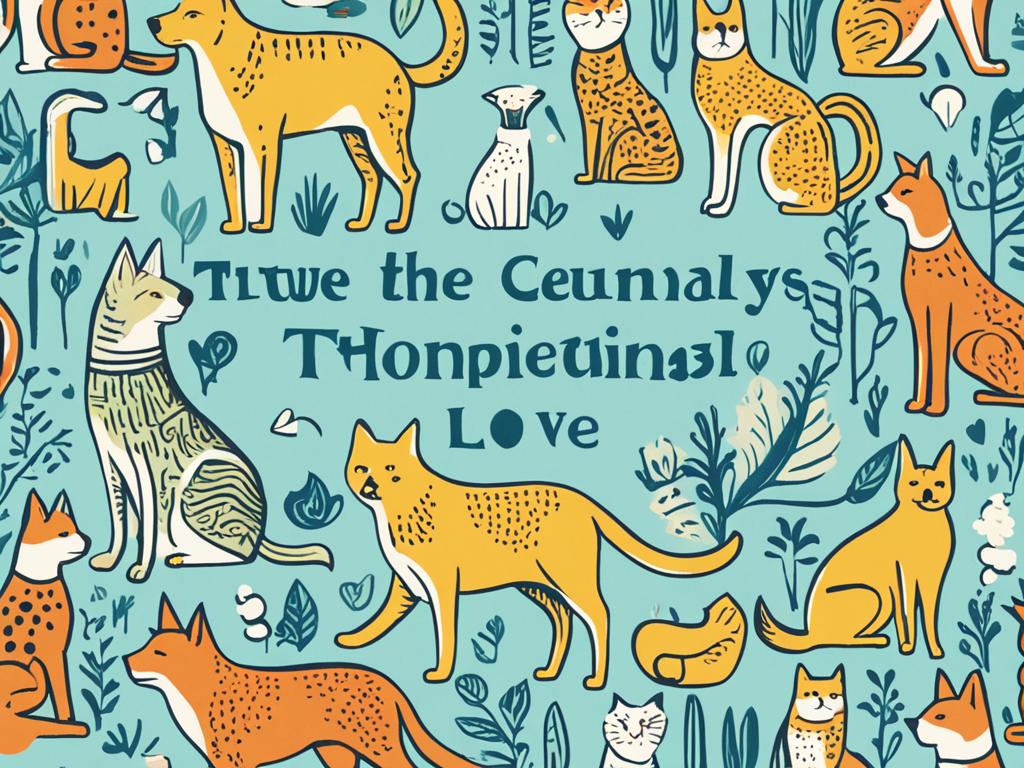As a professional copywriting journalist, I’m excited to explore the profound impact that pets have had on our cultural and social landscapes. According to the World Health Organization, pets can contribute to our emotional, social, and physical well-being, making them an integral part of our lives. The domestication of dogs and the co-evolution of humans and our animal companions have played a significant role in shaping our cultural values, social norms, and interpersonal relationships throughout history.
Pets are increasingly recognized as important cultural symbols, social catalysts, and sources of emotional support, with their presence influencing everything from child development to mental health. In this comprehensive article, I’ll delve into the multifaceted ways in which pets have influenced and continue to shape our cultural and social constructs around the world.
Key Takeaways
- Pets have a profound impact on human health and well-being, contributing to emotional, social, and physical benefits.
- The domestication of dogs and the co-evolution of humans and pets have shaped our cultural values, social norms, and interpersonal relationships.
- Pets are recognized as important cultural symbols, social catalysts, and sources of emotional support.
- Pets can influence child development and mental health through their presence and companionship.
- This article explores the multifaceted ways in which pets have influenced and continue to shape our cultural and social constructs.
The Evolution of Human-Animal Bond
The relationship between humans and animals, particularly dogs, has ancient origins dating back thousands of years. Genetic evidence suggests that dogs were first domesticated from wolves in Europe, with the process of dog domestication involving complex social and cognitive adaptations. As humans and dogs co-evolved, their bond deepened, leading to the development of service animals that have played a crucial cultural role, such as guide dogs for the visually impaired.
Ancient Origins of Dog Domestication
The journey of dog domestication can be traced back to the Paleolithic era, where early human societies began to forge strong connections with wolves. Through a process of selective breeding and social integration, these wild canines gradually transformed into the companion animals we know and love today. This co-evolution between humans and dogs has had a profound impact on cultural traditions and the ways in which we perceive and interact with the animal kingdom.
Co-Evolution of Humans and Pets
As humans and pets continued to coexist and adapt to one another, their relationship evolved in complex and fascinating ways. The human-animal bond deepened, with pets becoming increasingly integrated into the social fabric of human societies. This co-evolution has not only shaped our cultural practices but also influenced our cognitive and emotional development, as evidenced by the profound impact of companion animals on child development and mental health.
Cultural Significance of Service Animals
The role of service animals, such as guide dogs for the visually impaired, has become particularly significant in many cultural traditions. These highly trained and specialized animals have enabled individuals with disabilities to live more independent and fulfilling lives, while also fostering greater social inclusion and understanding. The cultural significance of service animals extends beyond their practical applications, as they serve as powerful symbols of the human-animal bond and the transformative potential of this relationship.
| Key Aspects of the Human-Animal Bond | Significance |
|---|---|
| Ancient Origins of Dog Domestication | The Paleolithic-era origins of the human-dog relationship, involving selective breeding and social integration |
| Co-Evolution of Humans and Pets | The deepening bond and mutual adaptation between humans and their animal companions, shaping cultural traditions and cognitive/emotional development |
| Cultural Significance of Service Animals | The crucial role of specialized service animals in enabling independence and social inclusion for individuals with disabilities, serving as powerful cultural symbols |
The Cultural Significance of Pets
Pets have evolved to become deeply embedded in human culture, serving as social catalysts that facilitate interpersonal connections and interactions. The phenomenon of anthropomorphism, where humans attribute human-like traits and emotions to animals, has further contributed to the cultural symbolism and significance of pets. Pets are often viewed as extensions of the family, and their presence can influence social norms, customs, and traditions, such as the creation of pet-friendly spaces and the rituals surrounding pet memorials.
Pets as Social Catalysts
The presence of pets can act as a bridge, fostering social interactions and breaking down barriers between individuals. Pet owners are more likely to engage in conversations and form connections with strangers, as the shared experience of pet ownership can facilitate the formation of new relationships and strengthen existing ones. Pets can serve as a common interest that brings people together, promoting a sense of community and social cohesion.
Anthropomorphism and Cultural Symbolism
The tendency to ascribe human-like qualities and emotions to animals, known as anthropomorphism, has played a significant role in the cultural symbolism and significance of pets. Pets are often perceived as family members, with owners engaging in rituals and traditions that reflect this emotional bond. The cultural symbolism of pets extends beyond their practical uses, reflecting the profound impact they have on human psychology and emotional well-being.

Pets and Child Development
The presence of pets has been shown to have a profound impact on a child’s emotional, cognitive, and social development. Studies have consistently demonstrated that children who grow up with pets often develop stronger emotional bonds and a greater capacity for empathy, which can have lasting effects on their overall well-being and healthy development.
Emotional Support and Attachment
Pets can serve as sources of comfort and companionship for children, providing them with unconditional love and emotional support. The emotional bond that children form with their animal companions can be a powerful tool in helping them navigate the challenges of childhood, fostering a sense of security and attachment that can be instrumental in their emotional and social growth.
Cognitive and Social Benefits
In addition to the emotional benefits, the presence of pets in a child’s life can also contribute to cognitive and social development. Studies have shown that children with pets often display improved language skills, enhanced problem-solving abilities, and increased social competence, as they learn valuable lessons about responsibility, empathy, and interpersonal relationships through their interactions with their animal friends.
The multifaceted benefits of pets on child development underscore the important role these beloved companions can play in shaping the lives of young people. From fostering emotional support and attachment to promoting cognitive and social growth, the presence of pets can have a profound and lasting impact on a child’s overall well-being and development.
Pets and Mental Health
The profound connection between pets and mental health has been well-documented. Numerous studies have revealed the remarkable benefits of pet ownership in reducing stress and anxiety, as well as combating loneliness and depression.
Reducing Stress and Anxiety
The presence of pets can have a profoundly calming effect on individuals, lowering physiological indicators of stress. Interacting with pets, such as petting or playing with them, has been shown to stimulate the release of oxytocin, a hormone associated with feelings of relaxation and well-being. This can lead to a significant reduction in stress and anxiety levels, promoting a greater sense of overall mental health and emotional stability.
Combating Loneliness and Depression
For those experiencing loneliness or depression, pets can provide a valuable source of companionship and a sense of purpose. The unconditional love and unwavering support offered by pets can help alleviate feelings of isolation and despair, contributing to improved mental health and an enhanced quality of life. Caring for a pet can also give individuals a sense of responsibility and routine, which can be beneficial in overcoming the symptoms of depression.
The relationship between pets and mental health is truly remarkable, with the benefits extending beyond individual well-being to the broader social and cultural landscape. By promoting stress reduction, combating loneliness and depression, and fostering emotional connection, pets have become invaluable allies in the pursuit of mental health and overall well-being.

Pets in Therapeutic Settings
The use of pets, particularly dogs, in therapeutic settings has become increasingly common in recent decades. Through the practice of animal-assisted therapy, these furry companions are trained to provide emotional support, cognitive stimulation, and physical assistance to individuals with a wide range of special needs, from autism to post-traumatic stress disorder.
Animal-Assisted Therapy
Animal-assisted therapy harnesses the unique bond between humans and animals to promote healing and well-being. Trained therapy dogs, for example, can help alleviate anxiety, reduce stress, and improve mood in patients undergoing medical treatment or struggling with mental health challenges. The presence of these pets in therapeutic settings can have a calming and uplifting effect, fostering a sense of safety and comfort that can be particularly beneficial for vulnerable individuals.
Service Dogs for Special Needs
Beyond the realm of animal-assisted therapy, service dogs have become instrumental in enhancing the independence and quality of life for people with physical or mental health challenges. These highly trained canines can be customized to provide specific assistance, such as guiding individuals with visual impairments, alerting those with hearing loss, or providing stability and mobility support for those with physical disabilities. The integration of service dogs into the lives of individuals with special needs has been transformative, empowering them to navigate their daily routines with greater autonomy and confidence.
The versatility and impact of pets in therapeutic settings highlights their profound influence on human well-being. Whether through the emotional support and cognitive stimulation of animal-assisted therapy or the practical assistance of service dogs, the presence of these beloved companions can be truly life-changing for those in need. As the field of pet-based interventions continues to evolve, the integration of pets into therapeutic practices promises to yield even greater benefits for individuals and communities alike.
Cultural Variations in Pet Ownership
The cultural significance of pets is not uniform across all societies, as pet ownership and the role of animals in human life can vary considerably. In some cultures, pet ownership is highly valued, leading to the creation of pet-friendly spaces and the integration of pets into social norms. In contrast, other cultures may have different attitudes towards animals, shaping the ways in which pets are perceived and incorporated into daily life.
Pet-Friendly Spaces and Social Norms
In regions where pet ownership is prevalent, there is often a greater emphasis on creating pet-friendly spaces that cater to the needs and preferences of both pet owners and their animal companions. This can include the development of pet-friendly parks, restaurants, and even housing complexes that accommodate pets. Additionally, social norms around pet ownership may be more lenient, allowing for a wider acceptance of pets in public spaces and everyday interactions.
Pet Memorials and Rituals
The rituals and memorials surrounding pet loss can also reflect cultural differences. Some societies place a greater emphasis on honoring the memory of beloved animal companions, incorporating pet-specific ceremonies, burial practices, or even the construction of pet cemeteries. These cultural traditions demonstrate the profound emotional attachment and significance that pets hold within certain communities.
Ultimately, the diverse cultural attitudes towards pet ownership highlight the multifaceted and dynamic nature of the human-animal bond. As societies continue to evolve, the integration of pets into cultural and social constructs will undoubtedly continue to shape our collective understanding and appreciation of the role of animals in our lives.

Pets and Social Status
In certain communities, the ownership of pets, particularly specific breeds or species, can be associated with social status. Pets may be viewed as status symbols, reflecting the owner’s wealth, lifestyle, and societal standing. This perception of pets as indicators of social status is a complex phenomenon that highlights the multifaceted role these animal companions play in our cultural and social constructs.
Pets as Status Symbols
The acquisition of certain pets, such as purebred dogs or exotic animals, can be seen as a display of affluence and social standing. These pets may be perceived as desirable possessions that demonstrate the owner’s ability to provide for their animal’s needs, as well as their access to exclusive or limited-availability pets. However, this view of pets as status symbols can sometimes overshadow the more profound emotional and psychological benefits that come with responsible pet ownership.
Responsible Pet Ownership
While the association between pets and social status is present in some communities, it is essential to emphasize the importance of responsible pet ownership. Providing appropriate care, training, and attention to the animal’s well-being should be the primary concern for any pet owner, regardless of their social status. Responsible pet ownership contributes to the overall well-being of the animal and can also positively impact social perceptions and cultural norms. By promoting the value of caring for one’s pet, we can help shift the focus from pets as status symbols to pets as cherished companions and integral members of the family.
The Impact of Pets on Society
The presence of pets in human society has had a significant impact, both economically and environmentally. The pet industry has grown exponentially in recent decades, generating billions of dollars in revenue and creating a vast network of products, services, and employment opportunities. This economic impact of the pet industry has become an increasingly important factor in our society.
However, the environmental considerations surrounding pet ownership have also become a growing concern. The resources required to produce pet food, as well as the waste generated by pet owners, have a tangible impact on the environment. As the cultural significance of pets continues to evolve, it is crucial to consider the broader societal implications, both positive and negative, to ensure the well-being of both humans and their animal companions.
Pet Industry and Economic Impact
The pet industry has become a significant contributor to the economy, with a wide range of products and services catering to the needs and desires of pet owners. From pet food and supplies to veterinary care and grooming services, the industry has expanded rapidly, generating substantial revenue and creating numerous job opportunities. This economic impact of the pet industry has become an integral part of our society, reflecting the deep-rooted cultural significance of pets.
Environmental Considerations
While the presence of pets in our lives brings immense joy and companionship, their environmental impact cannot be overlooked. The production of pet food, particularly for popular domestic animals like dogs and cats, requires significant resources, such as land, water, and energy. Additionally, the waste generated by pets can have a detrimental effect on the environment if not properly managed. As the impact of pets on society continues to evolve, it is crucial that pet owners and industry stakeholders work to address these environmental concerns and promote sustainable practices.
Pets in Art and Literature
The cultural significance of pets has been profoundly reflected in various forms of art and literature throughout history. Pets have often served as muses, inspiring artists and writers to create works that capture the unique bond between humans and their animal companions.
Pets as Muses and Inspiration
From the captivating paintings of renowned artists like Claude Monet and Pablo Picasso, who immortalized their beloved pets on canvas, to the lyrical poetry of Elizabeth Barrett Browning and Emily Dickinson, which celebrates the emotional connection between humans and pets, the presence of animals has played a crucial role in shaping the creative expression of countless individuals. The enduring influence of pets as muses and sources of inspiration underscores their profound impact on human creativity and the cultural significance they hold.
Representations in Media and Pop Culture
The representation of pets in media and pop culture has also contributed to the cultural perceptions and symbolic meanings associated with these beloved animals. From the iconic canine companions in classic films like Lassie and Old Yeller, to the anthropomorphized pets that have become beloved characters in animated movies and television shows, the portrayal of pets in popular media has helped to shape and reinforce the cultural significance of these animals. The enduring presence of pets in various forms of media and entertainment further highlights their enduring influence on human expression and the ways in which they are perceived and celebrated in modern society.
Conclusion
In conclusion, the cultural significance of pets is undeniable, as they have profoundly influenced and shaped various aspects of human society. From their ancient origins to their contemporary roles as emotional support, therapeutic, and status symbols, pets have become deeply embedded in our cultural and social constructs. The impact of pets extends beyond individual well-being, as they also play a crucial role in shaping societal norms, traditions, and even the broader economic and environmental landscape.
As the conclusion of this comprehensive article, it is clear that the human-animal bond continues to evolve, and it is important to recognize and understand the key takeaways of the multifaceted ways in which pets have influenced and will continue to shape our cultural and social experiences. From enhancing child development to promoting mental health, the presence of pets has had a profound impact on our lives, and their significance will only continue to grow in the years to come.
Ultimately, the cultural significance of pets is a testament to the enduring and intricate relationship between humans and their animal companions. By recognizing and embracing the pivotal role that pets play in our society, we can cultivate a deeper appreciation for the bond we share and the invaluable contributions they make to our lives.
FAQ
What is the cultural significance of pets?
Pets have a profound impact on human health and well-being, contributing to emotional, social, and physical benefits. The domestication of dogs and the co-evolution of humans and pets have played a significant role in shaping cultural values, social norms, and interpersonal relationships throughout history.
How have pets influenced cultural traditions and social norms?
Pets are increasingly recognized as important cultural symbols, social catalysts, and sources of emotional support, with their presence influencing everything from child development to mental health. The phenomenon of anthropomorphism has further contributed to the cultural symbolism and significance of pets.
What are the benefits of pets for child development?
Studies have found that children with pets often develop stronger emotional bonds, a greater capacity for empathy, as well as cognitive and social benefits, such as improved language skills and increased social competence. Pets can serve as sources of comfort and companionship for children, contributing to their overall well-being and healthy development.
How do pets impact mental health?
The presence of pets can have a calming effect, lowering physiological indicators of stress and promoting feelings of well-being. For individuals experiencing loneliness or depression, pets can provide companionship and a sense of purpose, contributing to improved mental health and overall quality of life.
What is the role of pets in therapeutic settings?
The use of pets in therapeutic settings, such as animal-assisted therapy, has become increasingly common in recent decades. Pets, particularly dogs, can be trained to provide emotional support, cognitive stimulation, and physical assistance to individuals with a wide range of special needs, from autism to post-traumatic stress disorder.
How do cultural differences affect perceptions of pets?
The cultural significance of pets is not uniform across all societies, as pet ownership and the role of animals in human life can vary considerably. Some cultures may place a higher value on pet ownership, leading to the creation of pet-friendly spaces and the integration of pets into social norms, while others may have different attitudes towards animals.
How do pets relate to social status?
The ownership of pets, particularly certain breeds or species, can be associated with social status in some communities. Pets may be viewed as status symbols, reflecting the owner’s wealth, lifestyle, and societal standing. However, responsible pet ownership is also an important aspect that can contribute to social perceptions and cultural norms.
What are the economic and environmental impacts of pets?
The pet industry has grown exponentially in recent decades, generating billions of dollars in revenue and creating a vast network of products, services, and employment opportunities. However, the environmental impact of pet ownership, such as the resources required to produce pet food and the waste generated, has also become a growing concern.
How have pets influenced art and literature?
Pets have often served as muses, inspiring artists and writers to create works that capture the unique bond between humans and their animal companions. The representation of pets in art and literature has helped to shape and reinforce the cultural perceptions and symbolic meanings associated with these beloved animals.
Source Links
- https://www.ncbi.nlm.nih.gov/pmc/articles/PMC5369070/
- https://www.ncbi.nlm.nih.gov/pmc/articles/PMC8042315/
- https://www.nature.com/articles/s41599-019-0271-4

